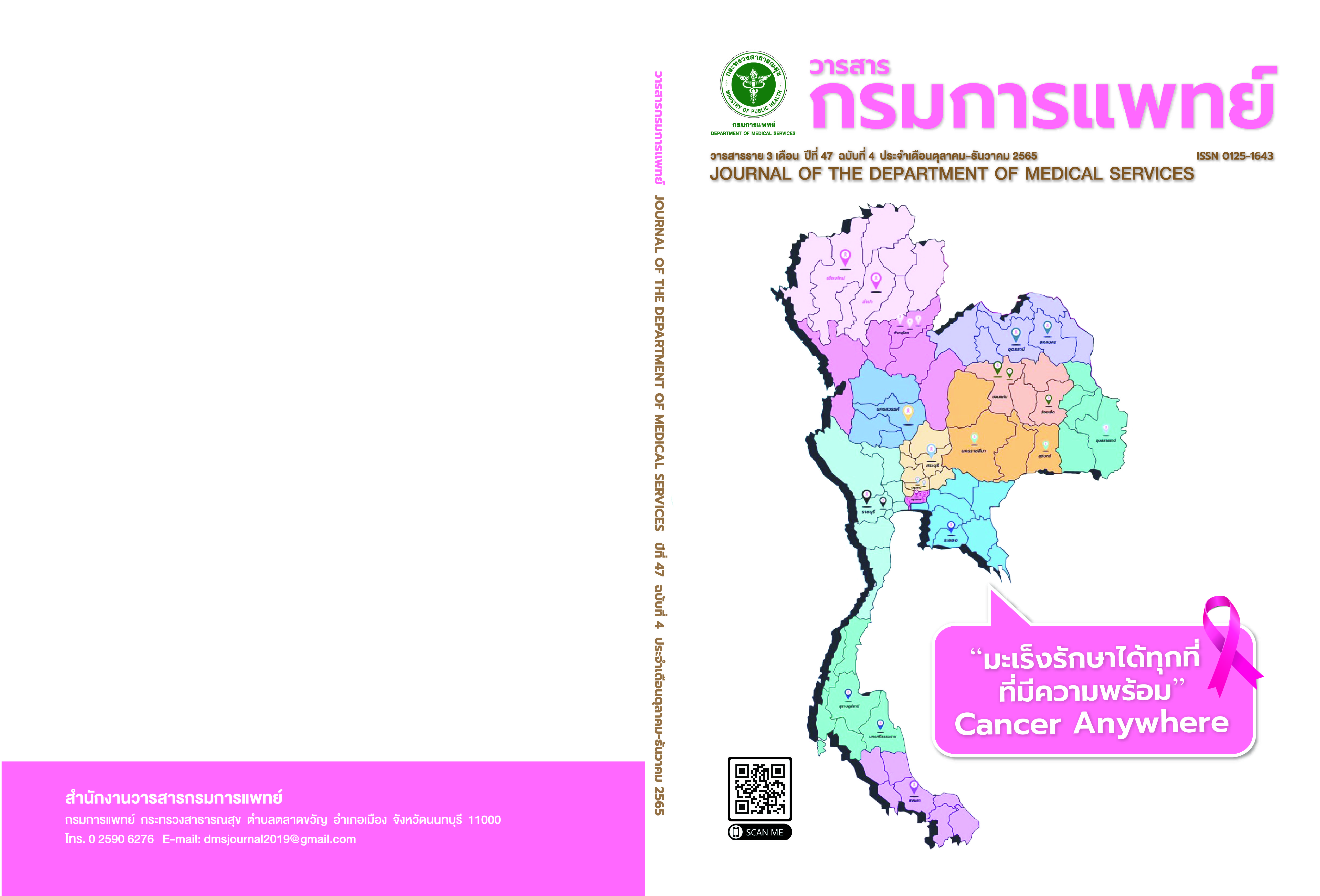Effects of Ergonomics Education on Knowledge, Dental Practice, and Musculoskeletal Disorders of Dental Personnel at the Institute of Dentistry
Keywords:
dental personnel, musculoskeletal disorders, MSDs, ergonomicsAbstract
Background: Dentists’ career is at high risk of developing musculoskeletal disorders. The symptoms may bemild or so severe that they affect the ability to work. Therefore, ergonomics education is necessary to prevent thosesymptoms. Objective: The objective of this research was to compare the mean score of knowledge, practice, andpain before and after receiving ergonomics education. Methods: This was quasi-experimental research. Data werecollected by conducting self-responding sample-type questionnaires. The questionnaire consisted of four sections:general information and health information, information about the dental working position and daily behavior,musculoskeletal pain symptoms and solutions, and a quiz measuring the knowledge of ergonomics. The samplegroup was dental personnel at the Institution of Dentistry: 50 dentists and 30 dental assistants. When the samplegroup had completed the questionnaires, they received leaflets advising about the ergonomic working position andstretching exercises. The data were collected again in the following month using the original questionnaire. Thestatistical data were then analyzed using the pair t-test and Wilcoxon Signed Rank test at 95%CI. Results: The resultsshowed that after receiving ergonomics education, the dentist’s group had a statistically significantly higher meanscore of knowledge and working posture than before receiving the education, whereas the dental assistants’ group’sresult was not different. However, both groups had the same mean score regarding the frequency and intensity ofpain before and after receiving ergonomics education. Conclusion: In the dentist’s group, ergonomics educationresults in increased knowledge of ergonomics and better practice in dental work; however, it does not affect thefrequency and severity of musculoskeletal disorders. We have also found that dentists had a statistically significantincrease in their knowledge of proper working postures. On the other hand, in the group of dental assistants, theergonomics education has not increased knowledge, practice in dental work, or the frequency and severity ofmusculoskeletal disorders.
References
Åkesson I, Johnsson B, Rylander L, Moritz U, Skerfving S.Musculoskeletal disorders among female dental personnel–clinical examination and a 5-year follow-up study of symptoms.International Archives of Occupational and EnvironmentalHealth. 1999; 72:395-403.
Chowanadisai S, Kukiattrakoon B, Yapong B, Kedjarune U,Leggat PA. Occupational health problems of dentists in southernThailand. Int Dent J. 2000; 50:36-40.
Hayes M, Cockrell D, Smith DR. A systematic review ofmusculoskeletal disorders among dental professionals. Int JDent Hyg. 2009; 7:159-65.
Brown J, Burke FJ, Macdonald EB, Gilmour H, Hill KB, MorrisAJ, et al. Dental practitioners and ill health retirement: causes,outcomes and re-employment. Br Dent J. 2010; 209:E7.
Suebnukarn S. Clinical skill development in dentistry: Ergonomicapproach. 2009.
Droeze EH, Jonsson H. Evaluation of ergonomic interventions toreduce musculoskeletal disorders of dentists in the Netherlands.Work. 2005; 25:211-20.
Gopinadh A. Ergonomics and Musculoskeletal Disorder: As anOccupational Hazard in Dentistry. The Journal of ContemporaryDental Practice. 2013; 14:299-303.
Kuorinka I, Jonsson B, Kilbom A, Vinterberg H, Biering-SorensenF, Andersson G, et al. Standardised Nordic questionnaires forthe analysis of musculoskeletal symptoms. Appl Ergon. 1987;18:233-7.
Esser AC, Koshy JG, Randle HW. Ergonomics in offce-basedsurgery: a survey-guided observational study. Dermatol Surg.2007; 33:1304-13; discussion 13-4.
Kierklo A, Kobus A, Jaworska M, Botulinski B. Work-relatedmusculoskeletal disorders among dentists-a questionnairesurvey. Ann Agric Environ Med. 2011; 18:79-84.
Finsen L, Christensen H. A biomechanical study of occupationalloads in the shoulder and elbow in dentistry. Clin Biomech(Bristol, Avon). 1998; 13:272-9.
Dajpratham P, Ploypetch T, Kiattavorncharoen S, BoonsirisethK. Prevalence and associated factors of musculoskeletal painamong the dental personnel in a dental school. J Med AssocThai. 2010; 93:714-21.
Marshall ED, Duncombe LM, Robinson RQ, Kilbreath SL.Musculoskeletal symptoms in New South Wales dentists. AustDent J. 1997; 42:240-6.
Alexandre PC, da Silva IC, de Souza LM, de Magalhaes Camara V,Palacios M, Meyer A. Musculoskeletal disorders among Braziliandentists. Arch Environ Occup Health. 2011; 66:231-5.
Ohlendorf D, Naser A, Haas Y, Haenel J, Fraeulin L, Holzgreve F,et al. Prevalence of Musculoskeletal Disorders among Dentistsand Dental Students in Germany. Int J Environ Res Public Health.2020; 17.
Abdollahi T, Pedram Razi S, Pahlevan D, Yekaninejad MS,Amaniyan S, Leibold Sieloff C, et al. Effect of an ErgonomicsEducational Program on Musculoskeletal Disorders in NursingStaff Working in the Operating Room: A Quasi-RandomizedControlled Clinical Trial. Int J Environ Res Public Health. 2020; 17.
Suteera Techatanawat, Tida Tangtragoonpaisarn. TheComparative Study of Electromyogram of Upper TrapeziusMuscle during Dental Practice between Dentist with and withoutUpper Back Muscle Pain. SwuDJ. 2012; 5:77-85.
Downloads
Published
How to Cite
Issue
Section
License
Copyright (c) 2022 Department of Medical Services, Ministry of Public Health

This work is licensed under a Creative Commons Attribution-NonCommercial-NoDerivatives 4.0 International License.
บทความที่ได้รับการตีพิมพ์เป็นลิขสิทธิ์ของกรมการแพทย์ กระทรวงสาธารณสุข
ข้อความและข้อคิดเห็นต่างๆ เป็นของผู้เขียนบทความ ไม่ใช่ความเห็นของกองบรรณาธิการหรือของวารสารกรมการแพทย์



